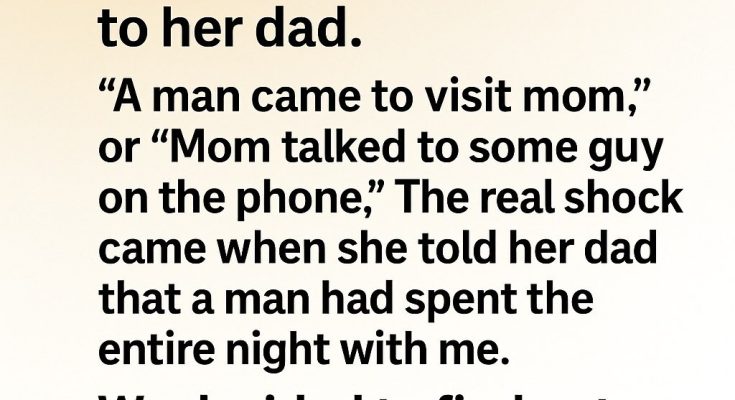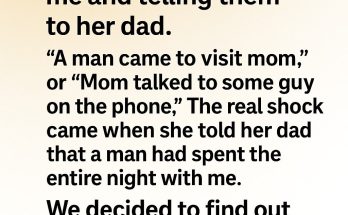My daughter, Lily, was a bright, imaginative three-year-old, a whirlwind of energy and fantastical narratives. Her days were filled with make-believe, and her stories were usually a delightful mix of talking animals, sparkly princesses, and daring adventures in our backyard. But lately, her tales had taken a strange, unsettling turn.
“The little girl with the red shoes is sad because her teddy bear is lost in the big, dark cupboard,” Lily would announce over breakfast, stirring her cereal with unusual seriousness. Or, “The old man next door has a secret key, and he uses it to unlock the moon.”
My husband, Tom, and I would chuckle, marveling at her vivid imagination. But the stories became more frequent, more specific, and oddly repetitive. She talked about a “tiny scratchy spider” that lived under the bed, a “sad bird” that sang outside her window every night, and most frequently, a “broken toy car” hidden beneath a cushion in the living room. She’d recount these details with such conviction, her brow furrowed, as if remembering actual events.
We tried to play along, asking her to tell us more about the “sad bird” or the “little girl with red shoes.” But her answers were always vague, fleeting, and usually ended with her shrugging her shoulders and running off to play. It was endearing, but also a little perplexing. We started to wonder if she was just inventing elaborate dreams, or if her imaginative play was simply becoming more complex.
Then, one rainy Saturday afternoon, as we were trying to coax her into tidying her overflowing toy box, Lily suddenly stopped. She pointed a small, determined finger at an old, slightly worn blanket draped over the back of the armchair. “The broken toy car lives there,” she declared, her eyes wide. “It’s under the blanket, and it’s very sad.”
Tom and I exchanged a look. There was no toy car under the blanket, or so we thought. We often used that blanket for fort-building, and toys frequently got lost beneath it. To humor her, Tom lifted the blanket. Nothing. Just the worn fabric of the armchair.
Lily’s face crumpled. “No! It’s there! The sad car!” She started to cry, a genuine, heartbroken cry that startled us both. She wasn’t just imagining it; she truly believed the car was there.
Something clicked. Her conviction was too strong, her distress too real. We remembered the other stories: the red shoes, the lost teddy bear, the secret key. Could there be something more to this?
Tom, driven by her genuine upset, meticulously ran his hand over the cushion beneath where the blanket had been. He felt a small, hard lump. He dug his fingers deeper between the cushions, pulling out a dusty, forgotten toy car. It was indeed broken, one wheel snapped off, and its once vibrant red paint was scratched and faded.
Lily stopped crying instantly, her eyes widening as she saw the car. “The sad car!” she whispered, reaching for it. Her small fingers traced the broken wheel.
That single discovery blew open a whole new understanding. We had been dismissing her stories as pure imagination, but what if they were her way of communicating observations, feelings, or even memories that she didn’t yet have the vocabulary or cognitive ability to express clearly?
We started to pay closer attention. We went through the house, recalling her other strange narratives.
-
The “tiny scratchy spider”: We found a small, harmless spider web in a forgotten corner under her bed, precisely where she often pointed.
-
The “sad bird”: We realized that a little robin often perched on the branch outside her window, its song sometimes sounding melancholic to our ears, especially on cloudy days.
-
The “little girl with red shoes”: We remembered a children’s book we’d read a few weeks ago, featuring a character who wore bright red shoes and had a storyline involving a lost item.
-
The “old man next door with a secret key”: Our elderly neighbor, Mr. Henderson, indeed used a distinct, old-fashioned key to lock his garden shed, which housed a telescope he often used to look at the moon.
My heart shattered with a mix of awe and remorse. We hadn’t been listening properly. Lily wasn’t just telling strange stories; she was giving us clues, painting detailed pictures of her world through the only language she fully commanded: her vivid imagination. She was processing her observations, emotions, and memories, weaving them into narratives that, to an adult, sounded fantastical, but to her, were her honest attempts at sharing her reality.
From that day on, Tom and I made a conscious effort to engage with her stories differently. Instead of just laughing, we’d ask more specific, open-ended questions, encouraging her to elaborate. We’d look for the “real” elements within her fantastical tales, trying to see the world through her eyes.
My toddler kept telling strange stories until we finally understood why: she was simply telling us her truth, and it was our privilege, and responsibility, to learn how to listen.

